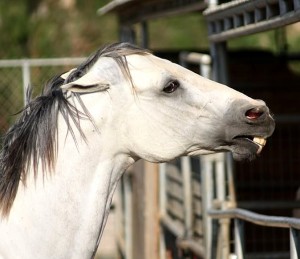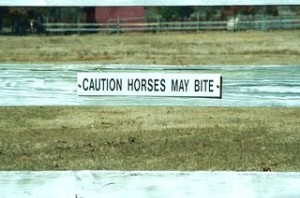 Writing in response to a recent question from a reader of my horse blog, I’d like to address the issue of how to correct a horse that bites you when you’re handling it. In this day and age of political correctness, what kind of discipline is acceptable to train a horse to not bite?
Writing in response to a recent question from a reader of my horse blog, I’d like to address the issue of how to correct a horse that bites you when you’re handling it. In this day and age of political correctness, what kind of discipline is acceptable to train a horse to not bite?
By pure chance, as I was thinking about this topic, I found an email in my inbox from Western Horseman Magazine, which has always been a huge inspiration to me as a training resource. Its headline was much the same as the headline of this article: “What Do You Do With A Horse That Bites?” The short article was written by a trainer whom I had never heard of, and as I read his advice, I was surprised and disappointed that he was advocating a mild reaction to a horse bite, and was careful to maintain a non-threatening and very politically correct form of remedying the situation. Basically, he said to move the horse’s feet and get him to respect you through lunging excercises and groundwork.
I have to scoff at this idea, even at the risk of being at odds with one of my favorite horse magazines—but a biting horse is not something to take lightly. I would never advocate abusing a horse or hurting it in an angry reaction to being bitten. But every horse owner should be equipped with the knowledge of correct timing, precise body language, and adequate force to correct this bad behavior.

First of all, you must understand why a horse bites in the first place. Horses bite to exert their dominance over other horses in the herd. Biting shows a lack of respect. Even as foals will nip at their mothers in a playful way, they are showing their familiarity and therefore their disrespect by biting at their mothers. If any other horse were to nip at the mare, she would most likely bare her teeth and lunge at the offending horse, driving it away harshly and even whirling and kicking it as hard as she can—but she will tolerate unruly behavior from her own foal. Biting is a natural instinct in horses, as a form of communication. And it always communicates disrespect.
Just as horses understand the body language of other horses in their herd, a horse will understand your actions if you discipline it for biting you. It is important that your timing is swift—immediately following the bite, or even as the horse’s teeth are still reaching for you. If you can see it coming and rise to meet it, that is the most effective way to train a horse to stop biting, because it corrects it immediately or as it’s happening, and the horse will associate the bad behavior with the repercussion it receives and will stop biting. If you wait too long—over two seconds is too long—then the horse won’t understand you at all, and will simply think you’re being mean. You must behave as a dominant horse in the herd, and “bite back” immediately when a horse disrespects you.
So what should your action be? There is nothing wrong with a good strong slap with the hand. It is not overly painful to a horse to be slapped, but the suprise of it, the sound of it, and the initial sting of it should get your message across clearly: This person does not tolerate biting. For those who protest, thinking a slap is abusive or equated with beating a horse, I would suggest that they try it on themselves first, and that will prove my point. A good hard open-handed slap will be a shock, it will have a sudden loud sound, and it will sting for a few seconds. There is no lasting pain or bruise from it, but there is a lasting memory of it being unpleasant, and that is exactly what you need for the horse to learn to never bite again.
There is also the caution of avoiding hitting a horse around the head or face because you don’t want the horse to become head-shy. It is true that some horses are so sensitive that they shy away when you’re just trying to put the halter on, and perhaps this is caused by them being previously hurt or abused. But more likely, they are unused to a person handling their head and need more gentling exercises to convince them there is no harm in getting their halter put on. This type of horse will seldom be a biter, and your actions around it can remain calm and soothing. On the other hand, the type of horse that is a biter is almost never head-shy, and it will not create head-shyness in that horse to slap it as it is reaching to bite you, or in the following second after it has bitten you. A biting horse is acting out of aggression, and that is evidence enough that it does not have a shyness problem.
If a horse is nipping at me, or reaching at me with his teeth and I can see it coming, I will likely slap it on the muzzle as it is reaching for me. This clearly conveys to the horse that I do not tolerate biting, and he will stop it. If you are adamant about not hitting the horse’s face, the best place to slap it is on the side of the neck, about eye level. Its shoulder is one of the least sensitive areas of the horse, so slapping it’s shoulder would not have much effect at all. But a well placed slap on the neck area about ten inches behind the eye would get the horse’s attention and it would learn not to bite again.
You do not have to hit the horse hard—I suggest matching your severity to the force of its bite. If a horse is being playful and lightly using its lips to nip at your clothing or your arm as you are brushing it, just use a firm and tangible push to move its mouth away from you. You have to correct even the most gentle of nips—don’t think it’s cute!—because the horse is testing you for a reaction, and will become more insistent and the playfulness will turn into all-out biting and further disrespect of your space. If the horse is actually taking your arm or sleeve into its lips or teeth, or if you hear an audible snap when it nips at you, your reaction needs to be a harder slap, because that horse is really taking advantage of you and needs corrected more firmly.
If a horse is biting out of meanness, and really snapping his teeth at you in a non-playful manner, I would suspect that he is in pain or extreme discomfort. I would suggest maintaining a safe distance and trying to determine the reason for his behavior. If the horse is normally very gentle, but perhaps bites at you while you are tacking him up, it’s a good indication that you’re cinching him too tightly or too abruptly, and it’s pinching his skin and hurting him. So change the way you’re saddling him: take up the cinch in small increments, using your hands to smooth the skin beneath the girth to prevent pinching. A well-broke horse should never bite. If the horse is not gentle, and is biting at you over his stall door, for example, this is a very bad sign, and the horse may never be broken of this vice. A lot of stallions will be so aggressive they are dangerous to handle, and their handling should be left to professionals. For your own safety, do not think that you will train a horse to stop biting if he is already set in his ways, and overly aggressive with a “killer instinct.” That type of horse should be avoided, it is not worth getting hurt over.
One easy way to keep a good horse from getting a nipping habit is to refrain from feeding him treats by hand. Giving a horse hand-fed treats will encourage the horse to nibble at your fingers, nip at your pockets or clothing, and start an irritating habit of always expecting you to have something yummy in your hand. I never give treats as a reward during training. It is much better to put the treat in the horse’s feed pan at the end of your lesson. Or if you must give him a treat, at least place it on the ground or somewhere other than your fingers, and never allow the horse to prompt you for treats or search your pockets. Treats often divert the horse’s attention from the actual lesson you are teaching him, and instantly makes him think instead of how yummy that treat is. So instead of treats during training, use rest and relaxation and a nice pat on the neck when he does a good job.
If you have read this article and are in disagreement with my stance, just consider one more thing. A horse that bites is showing a deep-seated problem that will continue to evidence itself in other ways and most likely result in you getting badly hurt. A horse that exerts his dominance on the ground is going to maintain that dominance during riding and all other types of handling. He will be difficult to catch and bridle, he will resist letting you handle his feet, he will balk at trailer loading, he will refuse simple excercises, and will continue to be a problem. When you establish your dominance in that horse’s mind by consistent and calm correction when he bites, you adjust the horse’s mentality of where he stands in the pecking order. You need to stay on top, or you lose all credibility with that horse.
Watch horses in a herd, and you’ll see it as plain as day. They all know where they belong, and they are very comfortable when they know their boundaries. A young gelding is not going to trot up to the lead mare and bite and kick her. He knows from experience that the resulting actions from her are going to be painful. And yet he will maintain a respectful and happy relationship with the lead mare; you will see him following her, or moving aside a step when she approaches. He is not afraid for his life around her, but he knows that her movements affect where he should place his feet and what he should do. And this is the exact relationship you should seek with your horse. You be the lead mare. Do not tolerate bad behavior from your horse.

{ 5 comments }
I handle a young Thoroughbred mare, and she started getting into a habit of biting. Especially when tacking up.
After a few slaps on the shoulder she thinks very hard before doing it now. She’ll occasionally swing her head around, but yanks it back as soon as I give her ‘the look’. She figured it out very quickly.
thatcitycountrygirl.blogspot.com
One other thought I’d like to add to this is that when you are correcting a horse for biting, try to make the horse believe that his act of biting met with the immediate result of him being smacked. Almost as if the horse misjudged and ran into something—that’s how swift the slap should be, so that the horse believes he did it to himself. This way the horse does not associate any of the shock, surprise, or pain he feels with you, and won’t hold any grudges or fear of you in the future. If you wait a second too long to correct him, it will have a negative effect on the horse, he won’t understand it at all, and will harbor fear or resentment towards you from then on. So either do it quickly, or don’t do it at all.
I am so happy that someone finally gave an opposing opinion to advice given all to often in the name of “natural horsemanship.” I have tried the moving feet and getting busy without touching around the mouth because it is only playful. Does not work. I have only had my pony (a rather bold, stubborn but sweet Welsh) a year. I have a trainer and she had to ride him quite a few times before I could. The reason he is better under saddle is that he associates being ridden with respect and paying attention. I did the ground work and had not achieved that level of respect and attention. Would he disengage hq, move his feet etc. Oh yes. But when he was done listening on lunge or free lungeing, he was gone. I know from the dogs, as well, they respect and understand their Mamas corrections, so why not ours?
I have a bit more to this question. My gelding is 6 years old, owned for 3 years by me off site, and now with me for the last few months. I have had him trained for trails, no major ground work. Brought him to the ocean and he rode great, listened well. About a month or two into our work together, he started regressing, he would buck into a canter. Switched out to new saddles, still did it. He has progressively become worse so that he will not move at all, and we attempt to ride bareback now, so saddles are not an issue. If I give him a voice command, or give any leg pressure at all, he will aggressively attempt to bite, at which if he is met with resistance, he will try harder and half toss his head to throw me. I have had his back looked at, his legs, and working with a reiki specialist. His form is solid, he carries well in his back, especially since we ride without a saddle. all of his ground work that I can do with him is positive, he is curious, and responds well to speed and commands. it’s just when attempting to ride… How would you handle the intense biting attempts here?
It sounds like he needed some correcting the very first time he nipped at your cue, or bit, or refused to move forward. Forward motion should never be an option, as the balking or sitting back tendency in the horse will almost certainly lead to rearing, which is a very dangerous habit. So if this were my horse, I would have reacted a bit over the top at the very first sign of “regress”, as you put it. Insist on forward motion, getting a response in the horse’s feet first, and body second. From the sound of it, the horse has soured to your cues, and it would be best to ask for a professional to take him and correct those issues before you get hurt. I’m sorry this is happening, and hope it gets resolved safely.